I hope this isn’t a late post from me because I swore to myself not to write anything until I completely understand a certain solution. I am also mindful that I am not an expert on this subject, but a basic comprehension of the subject is more than sufficient to write the piece, and I believe that I am equipped enough to write some fundamentals now. This post is for everyone trying to learn and become familiar with the fundamentals and terminologies of Adobe Experience Platform in a layman’s approach.
According to Adobe, ‘Experience Platform, the foundation of Experience Cloud products, is an open system that transforms all our data (Adobe and non-Adobe) into robust customer profiles that update in real-time and uses AI-driven insights to help us to deliver the right experiences across every channel’. If we observe the preface from Adobe, there are several key terms in one single sentence that can induce us to think in different ways; for example, data transformation can be associated with ETL tools, customer experiences can be tied to CXM tools, AI-driven insights can be coupled to Data Science Workspace, and so on. If so, what is Adobe Experience Platform? Let’s start tunneling the fundamentals.
What does this name represent?
Adobe is ingenious in branding their CDP (Customer Data Platform) solution as Adobe Experience Platform. To say so, I should first explain what a platform and a Customer Data Platform are.
A platform, in layman’s terms, is a storage unit, analogous to our hard disk (or cloud). So, a Customer Data Platform is nothing more than a storage unit that holds the customer data. When I phrase customer data, I’m referring to both profiles (customer information like name, age, gender, residence, mail address, and so on., that are both PII and non-PII) and behaviors (What they did in their online and offline interactions with the brand, such as store visit, store purchases, calls to the call center, online purchases, and so on). We should also know that the purpose of any storage unit (i.e., hard drive or cloud) is not just to store data but also to execute software on top of it, which is a crucial point to remember in the final section of this post.
It is apparent that you should now ask me why other Adobe solutions such as Adobe Analytics (or any other Adobe solution) are not referred to as a platform by Adobe till now when it is still storing customer data (at the very least, online behaviors). Well, to answer that, we would also need to understand the difference between two more terminologies: Applications and Solutions.
Applications and Solutions
To be honest, it is difficult to separate or differentiate these terminologies because they are frequently intertwined; nevertheless, I will attempt to explain it from a layman’s perspective.
An application is mostly related to a software tool intended to do a specific task. I’d like to use the Business Intelligence and Data Visualization tools such as Tableau or Power BI as examples from our digital marketing unit. Both serve the same purpose, effective and ready-to-use data visualizations in order to discover hidden insights.
A Solution, on the other hand, is a collection of integrated applications or tools that work together to solve a wider business problem. Adobe Analytics, for example, retains the data collected (Platform as a service like CRM systems), provides ready-to-use data visualizations or RESTful endpoints for quick insights through Workspace (Like Tableau or Power BI), real-time analytics, segmentation across online channels, and so on. Thus, Adobe Analytics is always marketed as a solution rather than an application or tool or just a platform to store the customer data (though we used to call it an application mostly).
If we closely pay attention, we will also notice that even Tableau and Power BI are promoted as solutions since the enterprise version can offer more than just visualizations, such as data sharing and integration, query service, AI/ML predictions, and so on. However, I like to term them only as applications or tools since they serve a single important purpose; data visualization.
So, what is Adobe Experience Platform?
With all of the aforementioned layman definitions, I’d like to refer to Adobe Experience Platform as the enhanced Customer Data Platform. There’s a reason I’m getting to this conclusion; remember the hard drive note I mentioned earlier? If so, now is the moment to bring it to use. We all know that Google’s Platform Big Query was originally marketed only as a data warehouse before being supplemented with crucial key services such as Query Services, Data Science Services, Privacy Services, and so on. As a result, Big Query is no longer merely a data warehouse, but rather an enhanced version of a data warehouse or Customer Data Platform. Adobe Experience Platform is one such platform that includes both Application Services and Intelligent Services along with platform-specific services such as Identity Service, Privacy Service, Segmentation Service and so on built on top of it, as well as all of Adobe’s applications on the top tier, making the platform even more unique.

Did you notice how I divided Application Services and Intelligent Services from platform-specific services? Yes, because not all services are included with the standard edition of Adobe Experience Platform and must be purchased separately based on the needs of the organization. If you want me to explain all of these services, I will have to provide you with separate documentation, and therefore I will try to cover them one by one in my upcoming articles. However, below are the current list of Application and Intelligent Services built on the Adobe Experience Platform.
Application Services
Customer Journey Analytics
Journey Orchestration
Offer Decisioning
Real-time Customer Data Platform (Real-time CDP)
Real-time Customer Data Platform (Real-time CDP) B2B Edition
Intelligent Services
– Attribution AI
– Content and Commerce AI (beta)
– Customer AI
There is a debate around Adobe on whether to classify Application Services as Applications because they are identical to other Adobe Applications and are not included by default with the standard edition of Experience Platform, requiring add-on licensing. Other services, such as Identity Service, Privacy Service, Segmentation Services, Intelligent Services, and so on, can be termed platform-specific and can be consumed by any Application built on top of the Adobe Experience Platform. So, sooner or later, the above composition could well be replaced by the below one, and who knows, Adobe always evolves and surprise us with their ideas.

So, in layman’s terms, Adobe Experience Platform is an enhanced Customer Data Platform that can hold all data for Customers (Profiles & Behaviors across channels) and Products (Product attributes or any metadata). Once the data has been collected, a customer 360 degree can be established, and the findings can be activated across channels for better customer experience using the list of services and applications provided with and built on top of the platform respectively.
Final debate
Rather than relying on pre-existing market solutions, we would now have the power to construct our own solution from the ground up based on our own requirements, which is more realistic with the support of the Adobe Experience Platform. Once the solution is constructed, it is no longer referred to as Adobe Experience Platform but rather based on our desires, because Adobe Experience Platform is merely one component in the solution that assisted us in constructing such a personalized one. Furthermore, the solution’s components can be anything depending on our requirements and are never enterprise-specific i.e., Adobe or non-Adobe stated earlier by Adobe.
The more we know about something, the more we realize how much more we need to know and that’s the fascination in learning. Happy learning and contributing!
Note: It’s fine if you’re still unclear and perplexed about the Services section of Adobe Experience Platform; there are still a lot of gray areas in Adobe Experience Platform, but as it matures over time, we should gain a better picture.






